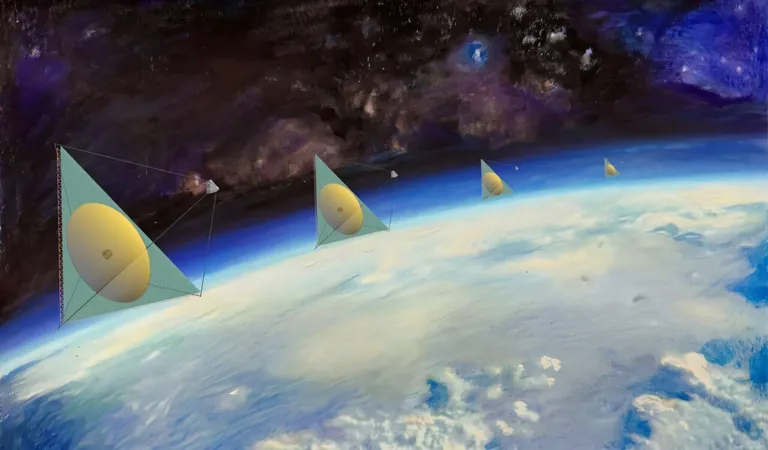
Revolutionary Space Telescopes: The Future of Astronomy with Membrane Technology!
2024-11-04
Author: Benjamin
Introduction
Space-based telescopes have long fascinated scientists and astronomers alike. Unlike those limited by the Earth’s atmosphere, these telescopes have the unparalleled ability to capture breathtaking images of distant celestial bodies with unmatched clarity. However, despite the groundbreaking capabilities of instruments like the James Webb Space Telescope, which features a primary mirror of just 6.5 meters in diameter, there are significant constraints on mirror size due to launch limitations. Just imagine the possibilities with a mirror as expansive as 39 meters, like the one being constructed at the Extremely Large Telescope in northern Chile!
Membrane Technology in Telescopes
A new groundbreaking study authored in Space Telescopes and Instrumentation 2024: Optical, Infrared, and Millimeter Wave explores the potential of creating space telescopes with mirrors made from ultra-thin membranes that can be unfurled to immense sizes. The essence of this innovative approach lies in the realization that all that is required for a telescope mirror is a reflective surface. There's no need for a hefty glass substrate or a rigid support structure—after all, it's the reflective quality that captures starlight that truly matters.
Challenges of Membrane Mirrors
What if we could simply roll up a massive reflective sheet, like a 40-meter roll of aluminum foil, and send it into space? While this concept appears straightforward, the challenge remains: once unrolled, the membrane must retain its intended shape to ensure accurate astronomical observations. A sophisticated detector would also be needed to keep images precise and focused, necessitating a mechanism to maintain alignment with the broad mirror.
Addressing Deformation Issues
Although it might seem manageable to employ a lightweight support structure for this purpose, the practicalities become complex. One significant issue that scientists aim to tackle is the deformation of such a thin mirror over time, even in the vacuum of space. This remains a central focus of the current research.
Importance of Configuration
Maintaining a precise configuration is crucial for capturing sharp images. For instance, during the initial launch of the Hubble Space Telescope, the mirror's shape was inaccurately constructed—less than the thickness of a human hair—resulting in the need for extensive repairs during a shuttle mission. To produce clear images with the new membrane telescope, shifts and deformations must be corrected in real time.
Adaptive Optics as a Solution
One promising approach to address this challenge involves adaptive optics—a method regularly utilized in large ground-based telescopes to counteract atmospheric disturbances. By employing actuators behind the mirror, astronomers have historically corrected distortions that impede observation. However, if such a complicated actuator system were to be designed for a membrane telescope, it would challenge the very purpose of its intended simplicity.
Innovative Alternatives: Radiative Adaptive Optics
The research team proposes an innovative and less complex alternative: using laser projection. By projecting lasers onto the thin membrane, the mirror's shape can be dynamically altered through radiative recoil, allowing for real-time modifications to ensure optimal focus. Dubbed "radiative adaptive optics," this technique has shown promising results in laboratory experiments, suggesting that we may soon be able to launch colossal space telescopes without the need for sacrificing precision or clarity.
Conclusion
The future of astronomy could be revolutionized by these membrane telescopes, unlocking an era of exploration that surpasses our current capabilities. Are we on the brink of a new astronomical age, where the universe’s secrets are finally within reach? Stay tuned for updates on this extraordinary scientific advancement!









 Brasil (PT)
Brasil (PT)
 Canada (EN)
Canada (EN)
 Chile (ES)
Chile (ES)
 España (ES)
España (ES)
 France (FR)
France (FR)
 Hong Kong (EN)
Hong Kong (EN)
 Italia (IT)
Italia (IT)
 日本 (JA)
日本 (JA)
 Magyarország (HU)
Magyarország (HU)
 Norge (NO)
Norge (NO)
 Polska (PL)
Polska (PL)
 Schweiz (DE)
Schweiz (DE)
 Singapore (EN)
Singapore (EN)
 Sverige (SV)
Sverige (SV)
 Suomi (FI)
Suomi (FI)
 Türkiye (TR)
Türkiye (TR)